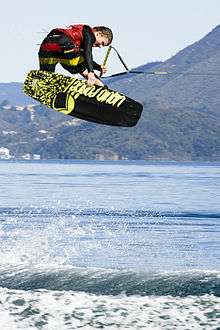Wakeboarding
Wakeboarding is a water sport in which the rider, standing on a wakeboard (a short board with foot bindings), is towed behind a motorboat across its wake and especially up off the crest in order to perform aerial maneuvers.[1] A hallmark of wakeboarding is the attempted performance of midair tricks.

The rider is usually towed by a rope behind a boat, but can also be towed by cable systems and winches, and be pulled by other motorized vehicles like personal watercraft, cars, trucks, and all-terrain vehicles. The gear and wakeboard boat used are often personalized to each rider's liking.
Wakeboarding is done for pleasure and competition, ranging from freestyle wakeboarding and wakeboard parks to wakeboard competitions at the X Games, WWA Wakeboard World Championships, or similar events.[2]
History
The sport that would later become wakeboarding began as wakesurfing, which was invented by surfers who were looking for an alternative to surfing when the sea was calm. Wakesurfing began picking up traction around 1964, where it was seen as an "exciting new sport that's soon going to sweep the waterways."[3] Although surfboards were originally used, boards without straps or bindings were first seen in New Zealand with boards called "skurfboards". Eventually, wakeboards with bindings or straps were sold in Australia under the name "McSkis". Later, another company called "Skurfer" was founded by Tony Finn in 1985,[4] named as such due to the board being a cross of a surfboard and a water ski. The first board made in the early 1990s was the Hyperlite board by the O’Brien company,[5] a water ski manufacturer who marketed the board as a “compression-molded neutral-buoyancy wakeboard.”[6] This was followed by a variety of boards that are curvier and more compact, creating a smoother ride.[6]
The wakeboard rope has advanced over the years with improvements in the material makeup. When wakeboarding first started, wakeboarders used ski rope, which was made with stretchy cloth or plastic ropes. The latter soon grew in popularity, and a braided rope made out of polypropylene was eventually introduced. A few years later, a rope that was less stretchy was invented that gave the rider a more consistent pull on the rope, though they were heavier and larger in diameter. Modern ropes are coated with Spectra and Dyneema, which decrease the stretch and drag of the rope.
Equipment
.jpg)
When wakeboarding, a wide variety of safety equipment is used. These include life vests or other buoyancy aids which prevent water-related injuries and deaths, as they keep the wearer buoyant until they are picked up. These vests especially help in situations where the rider is knocked unconscious or cannot tread water.[7] Furthermore, wakeboarders use water-resistant helmets that are able to ventilate water so that the helmets do not fill up with water.[7] Even the length of a wakeboarder's rope is important in providing safety; if the rope is too long, a wakeboarder will land on the flat part of the wake instead of the downside, and their knees will buckle.[8]

.jpg)
At the same time, the length of a wakeboarding rope will vary based on the rider's preferences. A longer rope may allow for more preparation and momentum before performing tricks,[9] whereas a shorter rope may require less speed and height to travel between wakes.[9]
Tricks
When wakeboarding, a variety of tricks may be attempted. Most of these stem from the wakeboarder adjusting their posture, edge, and distribution of weight so as to fly into the air upon hitting the wake.[10] Various tricks include the toeside edge,[10] the heelside edge,[11] the ride switch,[12] and the 180° spin.[13]
More advanced tricks call for what is known as inversion or “inverts”. An invert is considered any action where the board is above the head of the rider. This does not necessarily mean the rider is fully upside down, as evidenced by the Raley, a trick where the rider extends their body parallel to the water bending at the knees to achieve inversion.[14]
The heel side backflip, otherwise known as a tantrum, is often regarded as the first and easiest invert to learn as an intermediate level rider. This is because the shape of the wake or the “kicker” (a type of floating ramp, used primarily at cable parks, that mimics the shape of a wake) naturally initiates the sequence of motions which are necessary to complete the trick.[15]
References
- "Definition of WAKEBOARD". www.merriam-webster.com. Retrieved 2019-06-28.
- "Wakeboard Pro Top 5 | FISE Montpellier 2019 | FISE". www.fise.fr. Retrieved 2019-11-09.
- Borden, Dick (April 1964). "Make the most of your wake... ride it". Popular Boating. Ziff-Davis Publishing Company. Retrieved October 1, 2019.
- "TONY FINN | Inventor of wakeboarding |". Unleashed Wake Mag. 2016-12-11. Retrieved 2019-07-31.
- "O'Brien Wakeboards". O'Brien Watersports - Our World Is Water. Retrieved 2019-07-31.
- "Wakeboard". www.usawaterski.org. Retrieved 2019-06-28.
- "What Essential Wakeboarding Gear Do I Need?". Mpora. Retrieved 2019-06-20.
- "Wakeboard Boating Tips: Towing Speed, Rope length & Weighting". evo Culture, Community, Cause. 2013-05-15. Retrieved 2019-06-20.
- "Adjusting your wakeboard rope is the best kept secret to crush your trick list". Humanoid Wakeboards. 2018-08-15. Retrieved 2019-06-20.
- "Learn The Progressive Toeside Edge - Wakeboarder.com Wakeboarding News". www.wakeboarder.com. Retrieved 2019-06-21.
- "Learn the Progressive Heelside Edge - Wakeboarder.com Wakeboarding News". www.wakeboarder.com. Retrieved 2019-06-21.
- "Learning To Ride Switch - Wakeboarder.com Wakeboarding News". www.wakeboarder.com. Retrieved 2019-06-21.
- "Progressive Steps to Learn 180s - Wakeboarder.com Wakeboarding News". www.wakeboarder.com. Retrieved 2019-06-21.
- "Wakeboard Trick List". thewakeboardsite.com. Retrieved 2020-02-27.
- "Wakeboarder.com Tricks and Tips - Tantrum". www.wakeboarder.com. Retrieved 2020-02-27.